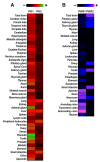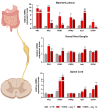The Prokineticin System in Inflammatory Bowel Diseases: A Clinical and Preclinical Overview
- PMID: 38001985
- PMCID: PMC10669895
- DOI: 10.3390/biomedicines11112985
The Prokineticin System in Inflammatory Bowel Diseases: A Clinical and Preclinical Overview
Abstract
Inflammatory bowel disease (IBD) includes Crohn's disease (CD) and ulcerative colitis (UC), which are characterized by chronic inflammation of the gastrointestinal (GI) tract. IBDs clinical manifestations are heterogeneous and characterized by a chronic relapsing-remitting course. Typical gastrointestinal signs and symptoms include diarrhea, GI bleeding, weight loss, and abdominal pain. Moreover, the presence of pain often manifests in the remitting disease phase. As a result, patients report a further reduction in life quality. Despite the scientific advances implemented in the last two decades and the therapies aimed at inducing or maintaining IBDs in a remissive condition, to date, their pathophysiology still remains unknown. In this scenario, the importance of identifying a common and effective therapeutic target for both digestive symptoms and pain remains a priority. Recent clinical and preclinical studies have reported the prokineticin system (PKS) as an emerging therapeutic target for IBDs. PKS alterations are likely to play a role in IBDs at multiple levels, such as in intestinal motility, local inflammation, ulceration processes, localized abdominal and visceral pain, as well as central nervous system sensitization, leading to the development of chronic and widespread pain. This narrative review summarized the evidence about the involvement of the PKS in IBD and discussed its potential as a druggable target.
Keywords: Crohn’s disease (CD); chronic pain; inflammatory bowel diseases (IBDs); prokineticin system; ulcerative colitis (UC).
Conflict of interest statement
The authors declare no conflict of interest.
Figures












Similar articles
-
A Review of Inflammatory Bowel Disease: A Model of Microbial, Immune and Neuropsychological Integration.Public Health Rev. 2021 May 5;42:1603990. doi: 10.3389/phrs.2021.1603990. eCollection 2021. Public Health Rev. 2021. PMID: 34692176 Free PMC article. Review.
-
Characterization of prokineticin system in Crohn's disease pathophysiology and pain, and its modulation by alcohol abuse: A preclinical study.Biochim Biophys Acta Mol Basis Dis. 2023 Oct;1869(7):166791. doi: 10.1016/j.bbadis.2023.166791. Epub 2023 Jun 17. Biochim Biophys Acta Mol Basis Dis. 2023. PMID: 37336367
-
A comprehensive review and update on Crohn's disease.Dis Mon. 2018 Feb;64(2):20-57. doi: 10.1016/j.disamonth.2017.07.001. Epub 2017 Aug 18. Dis Mon. 2018. PMID: 28826742 Review.
-
An Update on Herbal Products for the Management of Inflammatory Bowel Disease.Antiinflamm Antiallergy Agents Med Chem. 2023;22(1):1-9. doi: 10.2174/1871523022666230727094250. Antiinflamm Antiallergy Agents Med Chem. 2023. PMID: 37497699 Review.
-
Generalized Pyoderma Gangrenosum Associated with Ulcerative Colitis: Successful Treatment with Infliximab and Azathioprine.Acta Dermatovenerol Croat. 2016 Apr;24(1):83-5. Acta Dermatovenerol Croat. 2016. PMID: 27149138
Cited by
-
Anti-Inflammatory Effects of Spexin on Acetic Acid‑Induced Colitis in Rats via Modulating the NF-κB/NLRP3 Inflammasome Pathway.J Biochem Mol Toxicol. 2025 May;39(5):e70285. doi: 10.1002/jbt.70285. J Biochem Mol Toxicol. 2025. PMID: 40320895 Free PMC article.
-
Chronic binge drinking-induced susceptibility to colonic inflammation is microbiome-dependent.Gut Microbes. 2024 Jan-Dec;16(1):2392874. doi: 10.1080/19490976.2024.2392874. Epub 2024 Aug 20. Gut Microbes. 2024. PMID: 39163515 Free PMC article.
References
-
- Lemmens B., De Hertogh G., Sagaert X. Inflammatory Bowel Diseases. Pathobiol. Hum. Dis. 2014;2014:1297–1304. doi: 10.1016/B978-0-12-386456-7.03806-5. - DOI
Publication types
LinkOut - more resources
Full Text Sources
Research Materials
Miscellaneous

